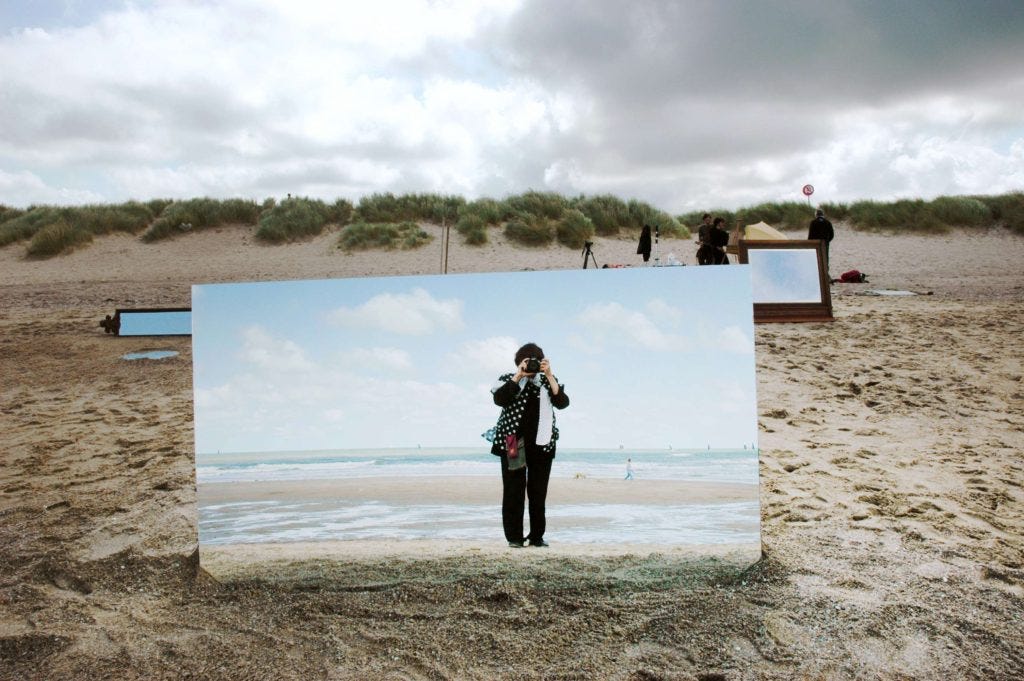Week 25.25 posts are all about memory . . . including shots from Apple Cider Vinegar (2025); The Beaches of Agnès (2008); The Farewell (2019); Can’t Hardly Wait (1998); and Volver (2006).
The Beaches of Agnès
This beautiful autobiography uses various imagery to exemplify a filmmaker literally looking back at and reflecting on her life and work.
This shot is poignant in its simplicity; it works as a stillframe, showing Agnès Varda bright and in focus, but not hiding the stormclouds, the crew and thus hard work it takes to make a film like this, and the various other setups she’s not in and may never make it to.
The Farewell
We’ve looked at examples of The Farewell subtly transitioning between scenes to mimic the ‘blurred together’ way we remember familiar patterns:
[it] either stutters, seems to cross a line, or jumps into a similar-but-different setup [to] evoke a feeling of repetition […] using the edit to give us the same sort of experience the characters are having.
This cut is intentionally disorienting to similar effect, while playing on the ‘rule of three.’
After showing us a pattern of three bows, the cut (0:34) interrupts the third bow — this jars us out of any complacency, understanding of pattern, ritual or reverie the scene has lulled us into.
On the cut the family members have all moved; instead of clustered together with faces visible, they’re spread out and looking away from camera. The grave markers are still oriented the same way in the frame, but the camera has shifted upwards making them appear different.
We know nothing has significantly changed, and yet everything appears different, the way memories shift even though ‘what happened’ is and will be always the same.
Apple Cider Vinegar
When Lucy (Tilda Cobham-Hervey) and Justin (Mark Coles Smith) catch a tram after dinner, the scene shifts to Lucy’s memory of a similar, happier walk earlier in their relationship.
Instead of using overt techniques — such as a whoosh noise accompanied by a flash of white across screen — to signal the change, it allows a culmination of other elements to show us the difference between current reality and Lucy’s memories; purple lighting versus green, walking on opposite sides of the street, starting on different sides of frame, different outfits and hair / wig, and different body language from the actors.
Though the differences add up, it’s not immediately clear when the scene cuts back and forth; it perhaps takes a second or two to recognise the intercutting which timeline we’re in.
That’s a feature, not a bug, making us feel how Lucy feels about her memories of a time and place she desperately wants to go back to.
Can’t Hardly Wait
Our memories are not trustworthy, and on top of that our narrators are often unreliable!
It's hard to tell whether one or both of those things are in play with this shot from Can't Hardly Wait . . .
but whatever's up with Ethan, the surreal lighting and too-convenient blocking out of key elements show us that what he's relaying isn't exactly how it went down in real life.



Volver
In Roger Ebert’s four-star review he notes how the camera establishes memory versus present day, and then combines them.
In Pedro Almodovar’s enchanting, gentle, transgressive “Volver,” a deceased matriarch named Irene (Carmen Maura) has moved in with her sister Paula (Chus Lampleave)
[. . .]
the women spend weekends cheerfully polishing and tending [their men’s] graves, just as if they were keeping house for them. In exemplary classic style, Almodovar uses a right-to-left tracking shot to show this housekeeping carrying us back into the past, and then a subtle, centered zoom to establish the past as part of the present.
More importantly Ebert explains why Almodóvar does this, how the technique serves the story of generations of women supporting each other through time and across death.
Women see time more as a continuity, anyway, don’t you think? Don’t you often hear them speaking of the dead in the present tense? Their lives are a continuity not limited by dates carved in stone.





